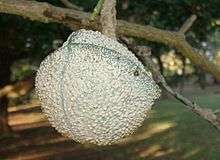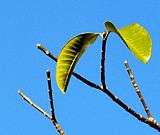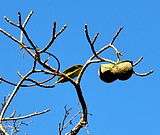Tabernaemontana elegans
Tabernaemontana elegans, the toad tree,[3] is a shrub or small tree in the family Apocynaceae. It is native to eastern Africa.
| Tabernaemontana elegans | |
|---|---|
 | |
| Warty fruit, holding numerous seeds | |
| Scientific classification | |
| Kingdom: | Plantae |
| Clade: | Tracheophytes |
| Clade: | Angiosperms |
| Clade: | Eudicots |
| Clade: | Asterids |
| Order: | Gentianales |
| Family: | Apocynaceae |
| Genus: | Tabernaemontana |
| Species: | T. elegans |
| Binomial name | |
| Tabernaemontana elegans | |
| Synonyms[2] | |
| |
Description
Tabernaemontana elegans grows up to 15 metres (50 ft) tall, with a trunk diameter of up to 30 centimetres (12 in). Its fragrant flowers feature white, creamy or pale yellow corolla lobes. Fruit consists of 2 separate ovoid or ellipsoid pods, up to 8 centimetres (3 in) each.
Distribution and habitat
Tabernaemontana elegans grows in forests or bushland from sea level to 1,000 metres (3,300 ft) altitude. The species is native to Somalia, Kenya, Tanzania, Mozambique, Zimbabwe, Eswatini and South Africa.[4][5][6]
Uses
Tabernaemontana elegans has some local medicinal uses including the treatment of heart disease, cancer, tuberculosis and venereal diseases. The species is also used as an aphrodisiac.[4] The Zulu name for this genus, iNomfi, refers to the use of their sticky, milky latex as bird-lime.[7]
Chemistry
Fourteen indole alkaloids have been isolated in the callus culture of Tabernaemontana elegans (isovoacangine, 3-R/S-hydroxy-isovoacangine, 3-R/S-hydroxy-coronaridine, isositsirikine, geissoschizol, tabernaemontanine, vobasine, vobasinol, apparicine, 16-hydroxy-16,22-dihydro-apparicine, tubotaiwine, 3-R/S-hydroxy-conodurine and monogagaine) of which apparicine is the principal.[8]
 opposite, entire leaves
opposite, entire leaves symmetrical fruit pods
symmetrical fruit pods
References
- Botanic Gardens Conservation International (BGCI) & IUCN SSC Global Tree Specialist Group (2019). "Tabernaemontana elegans". IUCN Red List of Threatened Species. 2019: e.T149502995A149502997. Retrieved 20 January 2020.
- "Tabernaemontana elegans". World Checklist of Selected Plant Families (WCSP). Royal Botanic Gardens, Kew. Retrieved 20 January 2020.
- "Tabernaemontana elegans". Germplasm Resources Information Network (GRIN). Agricultural Research Service (ARS), United States Department of Agriculture (USDA). Retrieved 20 January 2020.
- Medicinal Plants. PROTA. 2008. pp. 592–593. ISBN 978-9-05782-204-9.
- "Tabernaemontana elegans". Flora of Zimbabwe. Retrieved 4 August 2013.
- "Tabernaemontana elegans". Encyclopedia of Life. Retrieved 4 August 2013.
- Palmer, Eve (1977). A Field Guide to the Trees of Southern Africa. London, Johannesburg: Collins. pp. 303–304. ISBN 0-620-05468-9.
- Indole alkaloids from a callus culture of Tabernaemontana elegans. R. van der Heijden, R.L. Brouwer, R. Verpoorte, R. Wijnsma, T.A. van Beek, A.A. Harkes and A. Baerheim Svendsen, Phytochemistry, Volume 25, Issue 4, doi:10.1016/0031-9422(86)80013-9
| Wikimedia Commons has media related to Tabernaemontana elegans. |
